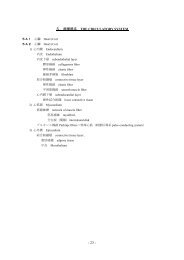Program / Abstract Book - KMU WWW3 Server for Education ...
Program / Abstract Book - KMU WWW3 Server for Education ...
Program / Abstract Book - KMU WWW3 Server for Education ...
You also want an ePaper? Increase the reach of your titles
YUMPU automatically turns print PDFs into web optimized ePapers that Google loves.
No. 72 (PP 5)<br />
The morphological change after molecular targeting therapy of malignant brain<br />
tumor<br />
Tatsuo Sawada 1 , Yoshinori Takekawa 2 , Saori Okamoto 3 , Takashi Maruyama 3 , and Noriyuki<br />
Shibata 1<br />
1 Department of Pathology, Tokyo Women’s Medical University<br />
2 Department of Neurosurgery Tokyo Women’s Medical University<br />
3 Department of Surgical Pathology Yokosuka Municipal Hospital, Japan<br />
(Background) The molecular targeting agents that are currently available <strong>for</strong> various malignant<br />
neoplasms. The effects of molecular targeting agents are divided into two subgroups, oncogene<br />
addiction (OA) and non-oncogene addiction (NOA). Bevacizumab, anti-vascular endothelial growth<br />
factor antibody is one of major agents of non-oncogenic addition although the therapy is permitted only<br />
experimentally in Japan. Malignant glioma, especially, glioblastoma (GB), and highly vascularized brain<br />
tumors are thought to be the one of the attractive targets <strong>for</strong> anti-angiogenic therapies. To elucidate<br />
morphological changes of tumor after NOD therapy is important to evaluate the effects of the drug. So<br />
we examined the morphological change of malignant glioma after Bavacizumab therapy using 3 autopsy<br />
cases.<br />
(Materials and Methods) Three cases in men were used. The range of age is from 37 to 64yrs. These 3<br />
cases received Bemacizumab therapy, and radiation therapies were combined. The microscopic slides of<br />
surgical resected and autopsied specimen were compared using HE and immunohistochemistry (IHC)<br />
<strong>for</strong> vascular endothelial growth factor, EGF A and C, vascular endothelial growth factor receptor, Fltand<br />
Flk-1, platelet derived growth factor (PDGF), CD31, CD34, smooth muscle cell actin (SMA) and<br />
aquaporin 1 and 4. And 5 cases of GB are examined <strong>for</strong> control.<br />
(Results) No significant change of morphology of tumor cells is identified after Bevacizumab therapy,<br />
but the morphology of neovasculature is different from conventional GB. A few glomeruloid<br />
appearances and hyperplasia of SMA positive cells are identified. On IHC, the reactivity <strong>for</strong> VEGF A<br />
was decreased but VEGF-C and Flt-1 were preserved.<br />
(Conclusion) The morphological difference between with and without administration of Bemasizumab<br />
in neovasculature suggests decreased expression of VEGF-A.<br />
- 125 -



